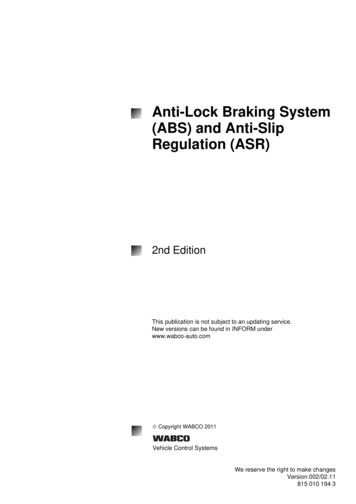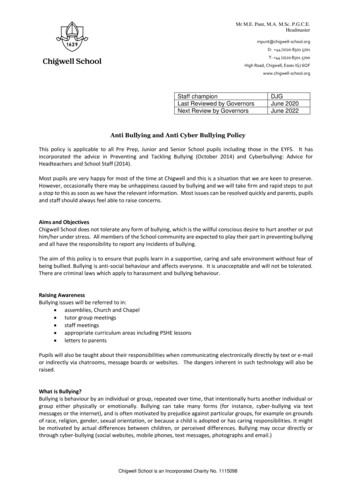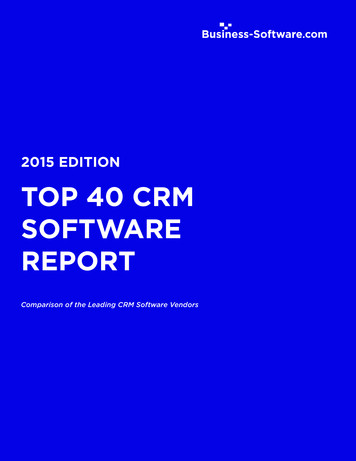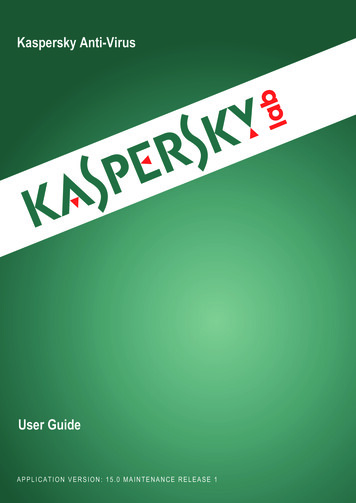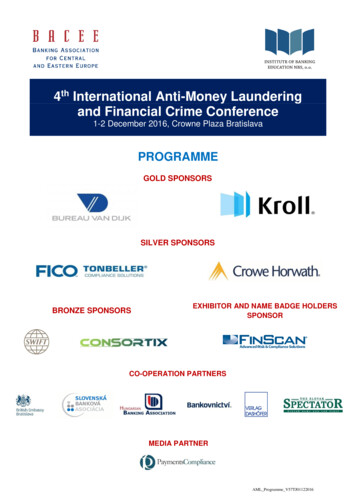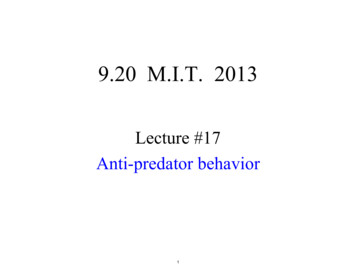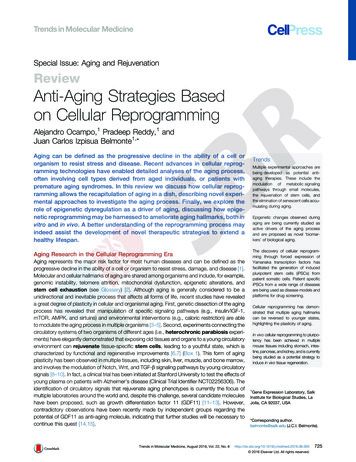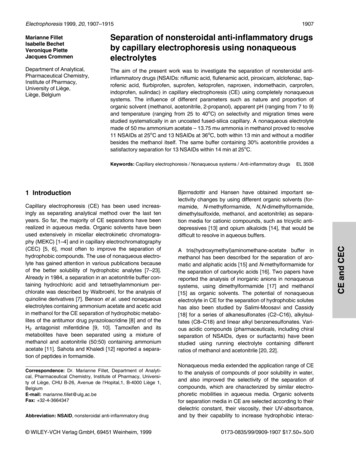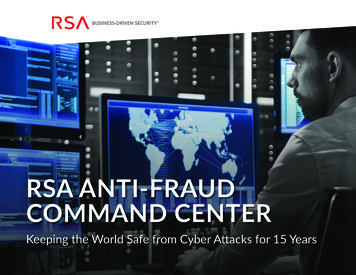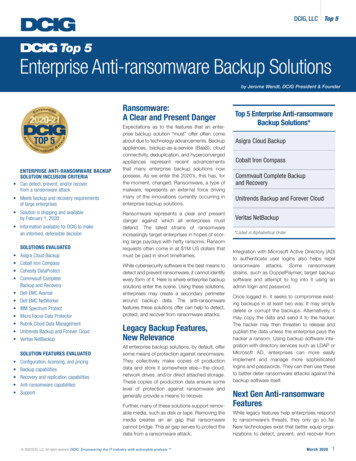
Transcription
DCIG, LLCTop 5DCIG Top 5Enterprise Anti-ransomware Backup Solutionsby Jerome Wendt, DCIG President & FounderRansomware:A Clear and Present DangerENTERPRISE ANTI-RANSOMWARE BACKUPSOLUTION INCLUSION CRITERIA Can detect, prevent, and/or recoverfrom a ransomware attack Meets backup and recovery requirementsof large enterprises Solution is shipping and availableby February 1, 2020 Information available for DCIG to makean informed, defensible decisionSOLUTIONS EVALUATED Asigra Cloud BackupCobalt Iron CompassCohesity DataProtectCommvault CompleteBackup and RecoveryDell EMC AvamarDell EMC NetWorkerIBM Spectrum ProtectMicro Focus Data ProtectorRubrik Cloud Data ManagementUnitrends Backup and Forever CloudVeritas NetBackupSOLUTION FEATURES EVALUATED Configuration, licensing, and pricingBackup capabilitiesRecovery and replication capabilitiesAnti-ransomware capabilitiesSupportTop 5 Enterprise Anti-ransomwareBackup Solutions*Expectations as to the features that an enterprise backup solution “must” offer often comeabout due to technology advancements. Backupappliances, backup-as-a-service (BaaS), cloudconnectivity, deduplication, and hyperconvergedappliances represent recent advancementsthat many enterprise backup solutions nowpossess. As we enter the 2020’s, this has, forthe moment, changed. Ransomware, a type ofmalware, represents an external force drivingmany of the innovations currently occurring inenterprise backup solutions.Ransomware represents a clear and presentdanger against which all enterprises mustdefend. The latest strains of ransomwareincreasingly target enterprises in hopes of scoring large paydays with hefty ransoms. Ransomrequests often come in at 1M US dollars thatmust be paid in short timeframes.While cybersecurity software is the best means todetect and prevent ransomware, it cannot identifyevery form of it. Here is where enterprise backupsolutions enter the scene. Using these solutions,enterprises may create a secondary perimeteraround backup data. The anti-ransomwarefeatures these solutions offer can help to detect,protect, and recover from ransomware attacks.Legacy Backup Features,New RelevanceAll enterprise backup solutions, by default, offersome means of protection against ransomware.They collectively make copies of productiondata and store it somewhere else—the cloud,network drives, and/or direct attached storage.These copies of production data ensure somelevel of protection against ransomware andgenerally provide a means to recover.Further, many of these solutions support removable media, such as disk or tape. Removing themedia creates an air gap that ransomwarecannot bridge. This air gap serves to protect thedata from a ransomware attack.Asigra Cloud BackupCobalt Iron CompassCommvault Complete Backupand RecoveryUnitrends Backup and Forever CloudVeritas NetBackup*Listed in Alphabetical OrderIntegration with Microsoft Active Directory (AD)to authenticate user logins also helps repelransomware attacks. Some ransomwarestrains, such as DoppelPaymer, target backupsoftware and attempt to log into it using anadmin login and password.Once logged in, it seeks to compromise existing backups in at least two way. It may simplydelete or corrupt the backups. Alternatively, itmay copy the data and send it to the hacker.The hacker may then threaten to release andpublish the data unless the enterprise pays thehacker a ransom. Using backup software integration with directory services such as LDAP orMicrosoft AD, enterprises can more easilyimplement and manage more sophisticatedlogins and passwords. They can then use theseto better deter ransomware attacks against thebackup software itself.Next Gen Anti-ransomwareFeaturesWhile legacy features help enterprises respondto ransomware’s threats, they only go so far.New technologies exist that better equip organizations to detect, prevent, and recover from 2020 DCIG, LLC. All rights reserved. DCIG: Empowering the IT industry with actionable analysis. limited and unrestricted distribution rights.March 20201
DCIG, LLCransomware attacks. These next gen features complement, ratherthan replace, the legacy approaches in defeating ransomware. Someof these next gen features include:1. Storing data in immutable object stores. Immutable object storesmay reside in multiple locations. These include on-premises, ingeneral-purpose clouds, purpose-built clouds, or any combinationthereof. Using an immutable object store, once data is written to it,the data cannot be erased though it can be overwritten.Overwrites may occur if the ransomware finds the object store andencrypts the data in it. However, if ransomware does encrypt it,one may configure the object store to retain older, previousversions of the data. In this way, one can recover and restoreearlier versions of the data.2. Integration with cybersecurity software. A backup solution’sintegration with cybersecurity software may occur in at least twoways. Some backup solutions partner with cybersecurity softwareproviders to help enterprises better secure their endpoint devicesfrom ransomware attacks. Others integrate cybersecurity softwareinto their offering to scan backup data for ransomware and alert toits presence. In both cases, the cybersecurity software helps organizations detect and defeat ransomware before it detonates, whichis always preferable.3. Artificial intelligence (AI) and machine learning (ML) algorithms.Using AI or ML, each scans production and/or backup data andlooks for abnormal change rates or unexpected changes to it.Detecting these changes can help alert enterprises to the possiblepresence of ransomware in their environment.Of these three next-gen technologies, AI and ML are perhaps themost immature. Currently, they cannot conclusively determine ifransomware resides in the data. Expect significant advancement inthis technology in the coming years. For example, they may moretightly integrate with cybersecurity software to better determine ifanomalous data does, in fact, contain ransomware.Distinguishing Features of EnterpriseAnti-ransomware Backup SolutionsDCIG identified over 50 solutions in the marketplace that offerbackup capabilities for businesses and enterprises. Of these 50,DCIG classified eleven of them as meeting DCIG’s definition of anenterprise anti-ransomware backup solution. These eleven solutions target large enterprise environments in their documentation.Attributes that distinguish enterprise solutions from those targeted atSMBs and SMEs include support for one or more of the following:1. Protecting multiple hypervisors and operating systems.Enterprise backup solutions support the most common hypervisors and operating systems as well as legacy operating systems.They all support common hypervisors such as Microsoft Hyper-Vand VMware vSphere as well as the Linux and Windows operatingsystems. However, these solutions will support other hypervisorssuch as Citrix XenServer, KVM, and Red Hat Enterprise Virtualization(RHEV). They will also support various versions of UNIX such asHP-UX, IBM AIX, and Oracle Solaris.Top 52. Protecting databases other than Microsoft SQL Server. Theother databases each one protects varies by solution. Most willminimally protect Oracle Database and Sybase databases.However, many support IBM DB2 and Informix, MySQL, andMongoDB, among others.3. Offering multiple deployment options. Enterprises may deploythe backup solution in one or more of the following, to include:backup appliance, software only, on-premises software-as-aservice (SaaS), cloud-based SaaS, and, as a hyperconverged infrastructure (HCI) solution.4. Storing and managing data in immutable object stores. Thesesolutions interface with immutable object stores through standardS3 application programming interfaces (APIs). These object storesmay reside in on-premises or off-premises locations such asgeneral-purpose and purpose-built clouds.5. Storing and managing data on removable media. These solutions initially stored backup data to removable disk and/or tape tosave money. However, storing data on removable media that isremoved and stored elsewhere creates an air gap to better protectdata from a ransomware attack.Similarities between the Top 5 EnterpriseAnti-ransomware Backup SolutionsIn addition to the features listed above that all enterprise antiransomware backup solutions generally share, the Top 5 solutionshave the following anti-ransomware traits in common. They include: Multiple deployment options for their solution. Some backupsolution deployment options provide a better defense againstransomware than others. Hosting the backup solution in the cloudor on a hardened physical or virtual appliance can help repel aransomware attack. Further, enterprises differ in how they maywant to deploy the backup solution in their environment. Enterprises may deploy each Top 5 solution as a cloud service or as aphysical or virtual appliance. Option to use Linux to host the backup software. The LinuxOS often gets mentioned as an effective means to deter ransomware attacks on the backup solution itself. All these solutions giveenterprises the option to use Linux to host their respectivebackup software. Multiple options to secure and validate user logins. The lateststrains of ransomware, such as DoppelPayer, specifically target andseek to access the backup software. They attempt to access it tocompromise, delete, or encrypt existing backups. Each backupsolution offers enterprises multiple options to authenticate user loginsand validate changes to existing backups. These options includetwo-factor authentication and integration with directory services. Making backup data inaccessible to other applications. Morestrains of ransomware specifically target enterprise environments.As part of their attack methodology, the ransomware seeks outand encrypts backup files and folders located on network attacheddevices. To mitigate this type of ransomware attack, all Top 5solutions make their backup files and folders inaccessible. 2020 DCIG, LLC. All rights reserved. DCIG: Empowering the IT industry with actionable analysis. limited and unrestricted distribution rights.March 20202
DCIG, LLCThe Top 5 solutions also deliver on the following data protection traits,which include support for: Client OSes to include Windows and the mostcommon distributions of Linux and UNIX Linux, Windows, and vendor-specific network file servers Microsoft Hyper-V, VMware vSphere, and Red HatEnterprise Virtualization (RHEV) hypervisors Microsoft SQL Server, MySQL, Oracle,and PostgreSQL databases Backup targets that include block- and file-baseddisk storage, cloud, and tape Data reduction features such as compressionand deduplication Full, incremental, and differential backups Optimizing bandwidth during replication operationsDifferences between the Top 5 EnterpriseAnti-ransomware Backup SolutionsThe Top 5 solutions differ in how they detect, prevent, and recoverfrom ransomware in the following ways: Detection. Backup solutions use the following techniques todetect ransomware: AI/ML algorithms to monitor changesto backup and production data Honey pots are files planted in the productionenvironment which the backup solution thenmonitors for changes Integrated anti-malware software that scansbackup data for ransomware Sand boxes to allow testing the backups for thepresence of ransomwareEach Top 5 backup solution may use none, one, or multipleof these techniques to search for or detect for the presence ofransomware. The more proactive techniques, such as the AI/MLalgorithms or the integrated anti-malware software, will detectransomware more effectively. Conversely, enterprises will findthe honey pot and sand box methodologies less disruptive toproduction operations to implement. Alerting and notification. All five solutions alert and notify if theydetect or suspect ransomware may exist in the environment.However, some solutions only notify the solution’s administratorswhile others can notify anyone. They also differ in the granularity oftheir reporting and how they configure reporting. Some rely onreporting tools that are part of their portfolio but are not native totheir backup solution. Once set up and configured, some only alertif ransomware might exist in the environment. Others alert onlywhen they detect ransomware’s actual presence. Remediation. Each backup solution responds to a perceived or realdetection of ransomware’s presence in the environment differently.Top 5Some automatically extend the retention period of all backups undermanagement. Others may lock down or quarantine backup files thatthey identify as infected. Some may take no actions on files at all.These solutions also differ in how they deliver on the following dataprotection traits: Breadth of hypervisor support. The backup solutions vary in theirlevels of integration and support for protecting Citrix XenServer,Linux KVM, and Nutanix AHV. Replication capabilities and management. Some enterprise mayneed more advanced forms of data replication. The solutions differin their abilities to replicate backup data in from or out to two ormore remote locations. Integration with cloud-native applications. All these solutionsoffer options to protect data residing in cloud-native applicationssuch as Microsoft Office 365. However, the methods they use toprotect these cloud-native applications vary significantly.Top 5 Enterprise Anti-ransomwareBackup Solution ProfilesEach of the Top 5 Anti-ransomware Backup Solution profiles highlightsthree or more ways each one differentiates itself. These differentiatorsrepresent some of the best methods that backup solutions offer todetect, prevent, and recover from ransomware. Within each solution,enterprises will find distinctive features that may better meet theirrespective needs.Asigra Cloud BackupAsigra Cloud Backup partners with a few independent cybersecuritysoftware providers to detect and protect backup data from ransomware attacks. Asigra combines the cybersecurity software engines’features with its own native data protection features to provide acomprehensive, enterprise anti-ransomware solution. Three distinctiveanti-ransomware features that Asigra Cloud Backup offers include: Bi-directional malware detection. Using Asigra Cloud Backup,enterprises may scan backups for ransomware when they backupdata, when they recover it, or both. Asigra Cloud Backup leverages the embedded cybersecurity software to scan data forransomware when it is backed up or recovered.Scanning during backups helps detect ransomware that peripherally focused anti-malware software may have missed. Scanningduring recoveries helps detect strains of ransomware that wereunknown (zero-day) at the time of their initial backups. Enterprises have the option to turn these scans on or off as the scansdo incur some overhead. Variable file and folder naming. Some strains of ransomwarespecifically target enterprise backup solutions and the backupsthey create. As part of these attacks, it scans network drives.During the scan, it looks for specific folder names or file extensions (such as “.bak”) created by the backup software. If discovered, the ransomware may attempt to delete or encrypt this datato hinder or defeat attempts at recovery. 2020 DCIG, LLC. All rights reserved. DCIG: Empowering the IT industry with actionable analysis. limited and unrestricted distribution rights.March 20203
DCIG, LLCAsigra Cloud Backup counters these ransomware attacks byproviding the option for it to create randomly generated file andfolder names. This tactic prevents ransomware from easilydetecting or compromising Asigra backups stored on the network. Alerts all concerned parties. When Asigra detects ransomwareduring a backup or recovery, enterprises may optionally configureit to alert anyone. Due to the pervasive threat that ransomwareposes, backup software should ideally alert more than justbackup administrators to its presence. Asigra Cloud Backup mayalert server admins, security admins, or any individuals who needto know about ransomware’s presence.Asigra Cloud Backup further distinguishes itself with its “most favorable” pricing model. Enterprises often must choose how they licensesoftware at the worst possible time: when they acquire it. At that time,enterprises may not know which licensing option is best for them orneed flexibility to change later. Asigra addresses these concerns.Asigra monthly evaluates how the enterprise utilizes its software. Itthen automatically applies which of the licensing metric options is thebest fit (i.e. - most economical) for the enterprise.Cobalt Iron CompassFounded in 2013, Cobalt Iron Compass provides a remarkably robustenterprise anti-ransomware solution considering its relative newnessto the marketplace. Cobalt Iron Compass provides the broader set ofcore backup and recovery features that enterprises expect anddemand. It simultaneously delivers the new set of anti-ransomwarefeatures that enterprises want. Three ways that Cobalt Iron differentiates itself from the other Top 5 anti-ransomware solutions include: Available as a SaaS solution. Enterprises may choose to hostCompass on-premises or with multiple general-purpose cloudproviders. Enterprises may choose to host Compass with AlibabaCloud, Amazon Web Services (AWS), Microsoft Azure, GoogleCloud Platform, and the IBM Cloud. Hosted in any of theseclouds, enterprises can also take advantage of each cloud’snative security features. Inaccessible backup infrastructure and data. Cobalt Ironmakes Compass’ underlying operating system, backup infrastructure, and data inaccessible. This approach simplifies Compass’administration and mitigates if not eliminates potential points thatransomware may use to attack.Cobalt Iron refers to its collection of security features as CompassCyber Shield. Only Compass software may access its backup filesas well as its underlying operating system, backup software andstorage. It also encrypts all data in-flight, at-rest, and can storestore on WORM media. These technologies mitigate and virtuallyeliminate any possibility of ransomware compromising backupscreated by Compass. Data authentication, validation, and monitoring to check forthreats. Cobalt Iron Compass distinguishes how it authenticatesand validates backup date in at least three ways. Compass firstperforms checksums and CRCs (cyclic redundancy checks, aspecific type of checksum) to catch data transmission and readerrors. Once validated, it then compares the newly written data toexisting data to check for any anomalies that may indicate thepresence of ransomware.Top 5Finally, Compass constantly monitors the entire backup infrastructure, to include backup data and operations. It looks for anyabnormal activity that may indicate the presence of ransomware.During these scans, it creates audit reports and generatesnotifications that alert to the possibility of a ransomware infection.Commvault Complete Backup and RecoveryCommvault Complete Backup and Recovery represents a long-timestalwart in the enterprise backup market. It has effectively evolved toincorporate cutting-edge anti-ransomware technologies such as AIand ML into its offering. It has supported both cloud and tape technologies for some time that effectively protect data from ransomwareattacks. Additionally, Commvault Complete delivers three other technologies that help distinguish it from other anti-ransomware backupsolutions. These include: Data isolation. Commvault uses data isolation and air gaps tosecure backed up data. Commvault Complete isolates copies ofdata and can optionally encrypt it, in a FIPS-compliant format.Further, Commvault blocks inbound access to the backup dataand only allows restricted outbound access to the source. To securedata communications, Commvault applies end to end encryption,inflight and at rest on the storage device. Commvault can severdevice communication automatically by creating an Air Gap. Application authent
that many enterprise backup solutions now possess. As we enter the 2020’s, this has, for the moment, changed. Ransomware, a type of malware, represents an external force driving many of the innovations currently occurring in enterprise backup solutions. Ransomware represents a clear and present danger against which all enterprises must defend.
